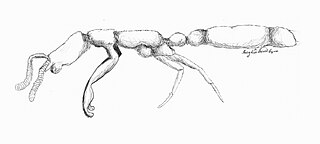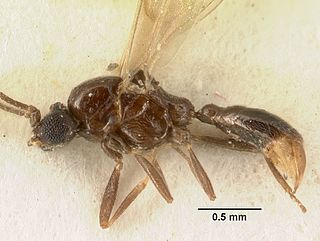
The name army ant (or legionary ant or marabunta) is applied to over 200 ant species in different lineages. Because of their aggressive predatory foraging groups, known as "raids", a huge number of ants forage simultaneously over a limited area.

Harpagoxenus is a genus of ants in the subfamily Myrmicinae. Found in the Palaearctic and Nearctic ecozones of the world, Harpagoxenus was first established as Tomognathus by Mayr (1861) to house the species Myrmica sublaevis. However, the name had already been used (homonym) for a genus of fish, and was replaced with its current name by Forel (1893).

Leptanillinae is a subfamily of primitive ants consisting of three genera.

Opamyrma hungvuong is a species of ant found in central Vietnam, first described in 2008. It is the only species in the genus Opamyrma. While originally classified in the subfamily Amblyoponinae, it is presently considered to belong to the subfamily Leptanillinae.

Myopias is a genus of ants in the subfamily Ponerinae. The genus is known from the Oriental, Indo-Australian, and Australasian regions.

Leptanilla japonica is an uncommon highly migratory, subterranean ant found in Japan. They are tiny insects, with workers measuring about 1.2 mm and queens reaching to about 1.8 mm, and live in very small colonies of only a few hundred individuals at a time Its sexual development follows a seasonal cycle that affects the colony's migration and feeding habits, and vice versa. L. japonica exhibits specialized predation, with prey consisting mainly of geophilomorph centipedes, a less reliable food source that also contributes to their high rate of nest migration. Like ants of genera Amblyopone and Proceratium, the genus Leptanilla engages in larval hemolymph feeding (LHF), with the queen using no other form of sustenance. LHF is an advantageous alternative to the more costly cannibalism. Unlike any other ant, however, members of Leptanilla, including L. japonica, have evolved a specialized organ dubbed the “larval hemolymph tap” that reduces the damage LHF inflicts on the larvae. LHF has become this species' main form of nutrition.

Yavnella is a genus of ants in the subfamily Leptanillinae. Its two species are distributed in India and Israel. The genus is known only from male specimens.

Anomalomyrma is an Asian genus of ants in the subfamily Leptanillinae. The genus was originally described in 1990 with the type species Anomalomyrma taylori, based on a single dealate queen from Borneo. Workers were unknown until 2011, when two new species were described from Peninsular Malaysia and the Philippines.

Leptanilla javana is a species of ant in the subfamily Leptanillinae.

Protanilla is a genus of subterranean ants in the subfamily Leptanillinae. Known from the Indomalayan realm, the genus contains about thirteen species. The genus was erected by Taylor (1990) for the type species P. rafflesi, described from workers from Peninsular Malaysia. Species in this genus have long and downcurved mandibles with peg-like tooth on the inner margins. Four species are known from China, one from Taiwan, one from Sri Lanka and a couple from India.
Gaoligongidris is an Asian genus of ants in the subfamily Myrmicinae. It contains the single species Gaoligongidris planodorsa, collected in the Gaoligong Mountains, Yunnan Province, China. The genus is known only from workers and nests in the soil, and forages on the ground. While similar to the genus Lophomyrmex of the tribe Attini, Gaoligongidris is most closely related to the Indo-Australian Lasiomyrma, tribe Crematogastrini.

Anomalomyrmini is a tribe of Leptanillinae ants with three extant genera.

Leptanillini is a tribe of Leptanillinae ants with two extant genera.

Leptanilla copiosa is a species of ant in the subfamily Leptanillinae, first described by Petersen in 1968 as Noonilla copiosa based on a male specimen from the Philippines. Noonilla was initially placed in the subfamily Leptanillinae, but was later removed from the subfamily when Ogata, Terayama & Masuko (1995) reviewed the genus, leaving the genus incertae sedis in the family. It was later readded to Leptanillinae.
Dolichoderus diversus is a species of ant in the genus Dolichoderus. Described by Emery in 1894, the species has a widespread distribution in multiple countries, including Brazil, Colombia, Costa Rica, Ecuador, Guyana, Mexico, Panama, Trinidad and Tobago and Venezuela.
Protanilla schoedli is a species of ant in the genus Protanilla. It was first described in 2006 from a gyne collected in Sri Lanka. It is named after Stefan Schödl.

Pseudoneoponera rufipes is a species of ant of the subfamily Ponerinae. It is found in southern and eastern Asia. Like other ants in the genus, they extrude a foam when disturbed.

Aetalionidae are a family of treehoppers in the superfamily Membracoidea. Aetalionidae are somewhat like Membracidae in that they have one to three rows of short spines on the hind tibia but differ in having the front femur fused to the trochanter and the scutellum is completely exposed. The females have finger-like protrusions on the genital capsule. The family is mostly Neotropical. The subfamily Biturritiinae is Neotropical while the subfamily Aetalioninae has a Neotropical genus Aetalion and the sole Old World representative genus Darthula with a single species Darthula hardwickii.












